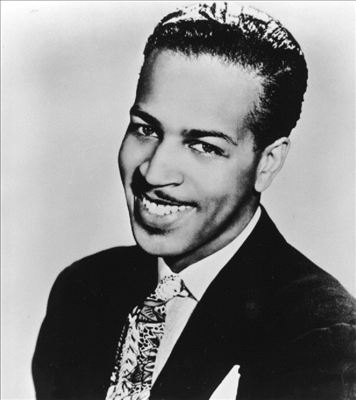 The Voice just kicked off its 7th season on NBC… Seems like a good excuse to talk about Wynonie Harris – a truly badass blues shouter who would send the smug, preening judges on (insert name of TV talent show du jour here) running for their lives.
The Voice just kicked off its 7th season on NBC… Seems like a good excuse to talk about Wynonie Harris – a truly badass blues shouter who would send the smug, preening judges on (insert name of TV talent show du jour here) running for their lives.
Yes, we’re a little starstruck when it comes to the man they called Mr. Blues. Here’s just two reasons why he’s on our shortlist of roots music heroes:
1. The great American drinking song… We covered this grand tradition here and here, and both posts feature towering achievements of the form by Harris, who spent most of his life conducting extensive research on all things alcohol. Here’s another shot of the good stuff: Drinking Blues
2. The great American “let’s get it on” song… That’s right, long before J-Lo sang the praises of her own booty and Marvin Gaye healed our sexuality, Wynonie cranked up the carnal heat with frisky little numbers like this one: Keep On Churning
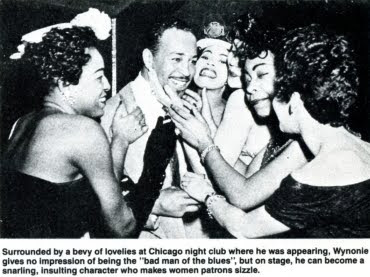 Harris also did a fair amount of research on the second subject, as King Records boss Syd Nathan and one of his partners discovered when they met their new hire in a Harlem hotel. “They knocked on the door of his hotel room and, invited to enter, walked into the room to find Wynonie lying in bed wearing only a pair of pink satin underpants, accompanied by three naked women” (Tony Collins’ liner notes from the appropriately named UK comp Lovin’ Machine).
Harris also did a fair amount of research on the second subject, as King Records boss Syd Nathan and one of his partners discovered when they met their new hire in a Harlem hotel. “They knocked on the door of his hotel room and, invited to enter, walked into the room to find Wynonie lying in bed wearing only a pair of pink satin underpants, accompanied by three naked women” (Tony Collins’ liner notes from the appropriately named UK comp Lovin’ Machine).
Oh, and his favorite word was motherfucker… Maybe Wynonie would have been a far more popular artist had he arrived on the music scene today.
But Harris clearly had the chops to back up all that swagger. I love Big Joe Turner… dig Roy Brown and Jimmy Witherspoon… get a little weak-kneed whenever I hear Big Maybelle or Eddie “Cleanhead” Vinson… but Wynonie combined that big, booming sound with just the right amount of grit and gravel. It’s like pouring a rich Chateaubriand sauce over chicken-fried steak (or at least that’s how I imagine it). All She Wants To Do Is Rock
It’s the sound of post-war, urban America, and Wynonie had the perfect background to become an R&B legend. A native of Omaha, he initially flirted with a career as a professional dancer (much like his contemporary, T-Bone Walker) and even studied medicine at Creighton University. But he couldn’t resist the sound of big-city blues, so naturally he started gigging in Kansas City in the late Thirties, where he was schooled by great singers such as Turner and Jimmy Rushing.
After a brief stint in L.A., he moved to Chicago and waited out the WWII recording ban by performing at the city’s storied Rhumboogie club, where he was discovered by Lucky Millinder. The R&B/swing bandleader took him to New York City, booked high-profile gigs at the Apollo Theater and the Savoy Ballroom in Harlem, and brought Harris into the studio in 1944 to record the singer’s first classic drinking song, Who Threw the Whiskey in the Well. The tune reached number one on the nation’s R&B charts the following year, which gave Wynonie all the encouragement he needed to pursue a solo career: Who Threw the Whiskey in the Well
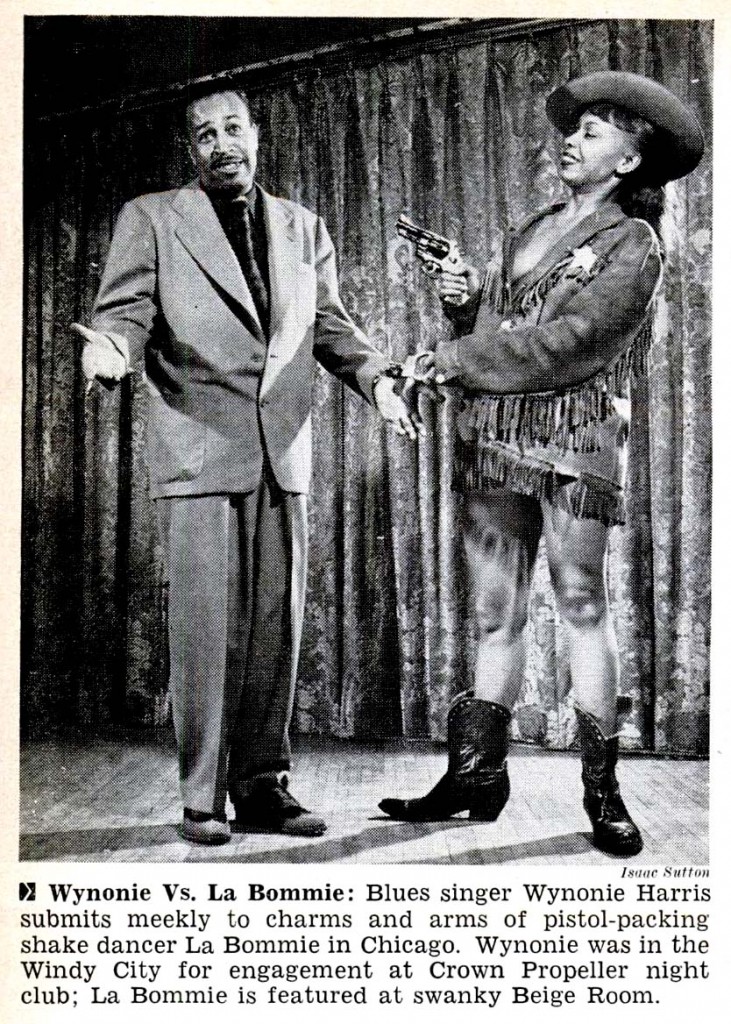 By the time Harris landed back in L.A. in 1945, he was a seasoned professional who needed no amplification at all, thank you, to get the attention of the hard-drinking patrons of Central Avenue’s crowded nightclubs. He joined forces that year with Johnny Otis to record another R&B hit, this one for the Philo label: Around the Clock, Pt. 1 And that set off a flurry of sessions for several other independent labels, including Apollo, Hamp-Tone (vibraphonist Lionel Hampton’s imprint) and Bullet.
By the time Harris landed back in L.A. in 1945, he was a seasoned professional who needed no amplification at all, thank you, to get the attention of the hard-drinking patrons of Central Avenue’s crowded nightclubs. He joined forces that year with Johnny Otis to record another R&B hit, this one for the Philo label: Around the Clock, Pt. 1 And that set off a flurry of sessions for several other independent labels, including Apollo, Hamp-Tone (vibraphonist Lionel Hampton’s imprint) and Bullet.
Which brings us to Wynonie’s glory years (roughly, 1947 to 1954), when he recorded one jump blues gem after another for Cincinnati’s King Records.
As we pointed out in this post, few labels (major or independent) could rival King’s output from the late Forties to the early Sixties – The Stanley Brothers, The Delmore Brothers, Moon Mullican, Cleanhead Vinson, Little Willie John, Freddie King, Hank Ballard, James Brown, etc. King was a true test for Harris’ fledgling career. And if Nathan had any doubts about his new find, they were quickly dispelled by one of Wynonie’s first singles for the label – a 1948 remake of a Roy Brown single that reached the top of the R&B charts and presaged the arrival of rock ‘n roll with Elvis’ version six years later: Good Rockin’ Tonight
Harris became a big draw on the R&B package tours that crisscrossed the country in the early Fifties. One drew about 10,000 fans to the Cleveland Arena in 1953 thanks to the promotional support of DJ Alan Freed, who hosted “The Moondog House” on WJW radio. The tour was headlined by Ruth Brown and included Buddy & Ella Johnson, jazz giant Lester Young, The Clovers and boxing champ Joe Louis, who was looking for any opportunity to pay off debt.
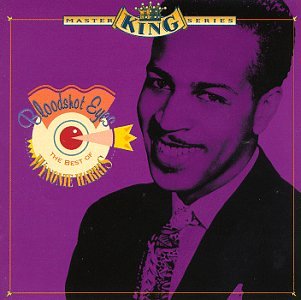 I have my favorite songs from Wynonie’s King years (including the previous tune and the ones sampled up front). Here’s a hard-rockin’ blues that helped introduce Harris’ moniker to the record-buying public in 1950. But his non-musical greeting might’ve been even more impressive. According to Galen Gart’s notes for Bloodshot Eyes, The Best of Wynonie Harris, “Wynonie would typically announce his entrance at his soirees with more than just a dash of bravado, telling his guests, ‘Mr. Blues is back in town, and I have enough money to air-condition Hell!’” Mr. Blues is Coming to Town
I have my favorite songs from Wynonie’s King years (including the previous tune and the ones sampled up front). Here’s a hard-rockin’ blues that helped introduce Harris’ moniker to the record-buying public in 1950. But his non-musical greeting might’ve been even more impressive. According to Galen Gart’s notes for Bloodshot Eyes, The Best of Wynonie Harris, “Wynonie would typically announce his entrance at his soirees with more than just a dash of bravado, telling his guests, ‘Mr. Blues is back in town, and I have enough money to air-condition Hell!’” Mr. Blues is Coming to Town
During the King years, Nathan recorded Harris in New York City and Linden, NJ with some of the best players in the business – Millinder and band, Hal Singer and Red Prysock on tenor sax, Ted Buckner on alto sax, Mickey Baker on guitar, etc. But it’s hard to top the label’s regular session crew in Cincinnati – especially pianist Sonny Thompson and band, heard to great effect on Freddie King’s signature songs (this one probably features Bill Johnson on guitar): Bring It Back
Wynonie scored another big R&B hit with this cover of a tune co-written by one of King’s many hillbilly artists, Hank Penny. I’m sure Nathan was pleased, since he owned the publishing rights to all of his artists’ songs (this one gave him a “two-fer,” since Penny’s single had already climbed the C&W charts). Bloodshot was recorded in NYC with some top-shelf talent, including Big John Greer on sax: Bloodshot Eyes
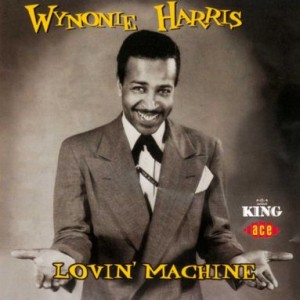 Harris’ final R&B hit (from 1952) is one of his best, featuring the locomotive sound of Todd Rhodes and his Orchestra. It’s hard not to appreciate the lyrics by Lambert Merritt, which seem to describe a prototype for Woody Allen’s Orgasmatron from the movie Sleeper: “Well you pull the lever on the right, two arms jump out… wrap all around you, make you scream and shout” (Merritt might have had Wynonie in mind when he added the line “when my machine finishes, that ain’t all – out comes a bottle of Hadacol!”). Lovin’ Machine
Harris’ final R&B hit (from 1952) is one of his best, featuring the locomotive sound of Todd Rhodes and his Orchestra. It’s hard not to appreciate the lyrics by Lambert Merritt, which seem to describe a prototype for Woody Allen’s Orgasmatron from the movie Sleeper: “Well you pull the lever on the right, two arms jump out… wrap all around you, make you scream and shout” (Merritt might have had Wynonie in mind when he added the line “when my machine finishes, that ain’t all – out comes a bottle of Hadacol!”). Lovin’ Machine
If you read our posts on Amos Milburn, The “5” Royales and Little Willie John (among other R&B legends), it shouldn’t surprise you that Harris’ fortunes faded with the arrival of rock ‘n roll and everything that followed. Of course some of his decline was self-inflicted, as years of smoking, heavy drinking and carousing (whatever that implies) finally caught up with him.
King let Harris go in 1954, although the label brought him back for two more sessions in ‘57 that resulted in at least one keeper. Then things more or less ground to a halt in the Sixties as his health worsened. He cut a handful of forgettable tracks for several labels (including Chess) and even ran a few taverns in New York and on the West Coast (probably not the best occupation for a full-blown alcoholic).
One of his final performances took place in 1967 at Harlem’s Apollo Theater, where he was joined by Big Joe Turner, T-Bone Walker, Big Mama Thornton and Jimmy Witherspoon – a heavenly lineup for jump blues fans. Then he passed away two years later at the age of 53 from esophageal cancer.
Although his death went virtually unnoticed at the time, he’s now recognized as a major influence on the first generation of rock ‘n rollers. So raise a glass – yes, even you bearded, bespectacled and overly sensitive indie rockers – to the man they called Mr. Blues.
No live footage of Wynonie Harris on YouTube… Might as well raise another glass:




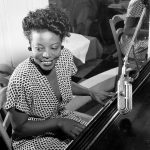
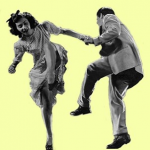
Excellent profile.
Nice one. May I enquire whether you have the 1994 biography Rock Mr. Blues: The Life & Music of Wynonie Harris by Tony Collins which now is out of print and fetches silly sums?
No I don’t. Would love to read it. Enjoyed his notes to the Ace comp. As you can tell, I’m fascinated by these R&B legends: Wynonie, Little Willie John, Big Maybelle, Cleanhead, Tiny Bradshaw, Earl Bostic, Bill Doggett… Hell, guys like Coltrane and Sonny Stitt played in some of these bands, and rock wouldn’t exist without them.
Oh, and thanks Mayor. I really fussed over this one (maybe too much, but I’ve always been hooked on Wynonie’s voice — a force of nature).
Here’s a scan of a review from Blues & Rhythm 100 (June/July 1995, p. 80 less photo).
ROCK MR. BLUES
THE LIFE AND MUSIC OF WYNONIE HARRIS
by Tony Collins
Big Nickel Publications USA
ISBN 0 936433 19 1
There are certain figures in the history of our music that are forever surrounded by an aura of mystique which adds to their appeal; men and women whose recorded careers are there for all to hear and enjoy, but whose private lives are shrouded in mystery and legend with only a few choice anecdotes to appease our lust for knowledge of them. Typically, these performers enjoyed a reasonably short recording career that was confined to the so called “golden years” of blues and R&B, were at least local heroes in their hey day and died in unusual circumstances or prematurely from drink, drugs or even violence just a handful that spring to mind are Charley Patton, Pinetop Smith, Robert Johnson, Leroy Carr, John Lee Williamson, Big Maceo, ‘Baby Face” Leroy Foster, Jazz Gillum, Pat Hare, Pete Lewis, Hot Lips Page and Billie Holiday. Due to the only relatively recent resurgence of interest in jump blues shouters, we have more than our share of these biographically challenged icons; Walter Brown, Sonny Parker, Crown Prince Waterford, Duke Henderson, Grant Jones, and, perhaps most surprisingly, Mr. Blues himself, Wynonie Harris.
Previously virtually our only biographical information on Mr. Blues has come from the sleevenotes to the unsurpassed trio of LPs issued by the much missed Jonas Bernholm, which stemmed from rare 1950s magazine articles and, particularly, the reminiscences of lifelong friend Preston Love, however Tony Collins has done us all a great service by expanding on that pioneering research work and through Preston has been able to contact and interview almost every living person who ever knew the great man. Tony, of course, is an occasional contributor to this magazine, notably with his fascinating appetiser “Wynonie Harris and the Big Rhythm and Blues Show of 1953” which we published in issue 92 in September of last year. The full book takes us from Wynonie’s birth in Omaha in 1913, his move to California in 1940, his big break with Lucky Millinder’s band in 1944, his conquering of New York City in 1946/47, to his halcyon days with King Records between 1947 and 1954, his fall from favour in the late 1950s and his retirement to L.A. in 1963 and the moving circumstances surrounding his death in 1969 (when he finally accepted his swiftly approaching demise from Cancer, Wynonie arranged a big party for all his old friends which he called his “Going Away Party”, without telling the guests to where he was going away they all assumed he was going back out on the road!).
There are plenty of more amusing, and indeed mischievous, stories and anecdotes to uphold Wynonie’s reputation as a “lad”, for instance Preston recalls that one of Wynonie’s favourite lines, particularly in ‘polite’ company, was “What kind of party is this and everybody’s got their clothes on?”, and Jean Prysock (wife of Arthur) tells of Wynonie’s talent at hypnotism, particularly over the young Sam Cooke. The book features eleven chapters covering 133 pages, together with a page devoted to Harris’s chart placings, a thirteen page sessionography, five pages listing all of Wynonie’s EP, LP, CD and cassette issues with full track listings, and ends with sixteen pages of text notes and sources and a useful index for future reference.
Most importantly, the book is liberally peppered with album sleeves, label shots, tour posters, newspaper clippings, publicity shots and more candid shots of Wynonie and many of his contemporaries and accompanists; my favourites are the King session photo from December 1947 showing Wynonie, Marion Abernathy, Hot Lips Page, and pianist Joe Knight, and the rare shots of him singing on stage at places like Harlem’s Baby Grand Club, Loew’s State Theatre and Omaha’s Dreamland Ballroom this is sadly the only pictorial evidence we will probably ever have of the great Wynonie Harris, unless a stage performance was captured on film by a fan or a previously unlisted soundie or snader transcription comes to light. Until then we all owe a debt of thanks to Tony Collins who had the nerve to undertake the, seemingly, impossible. Highly recommended to blues, jazz and R&B fans alike, however to those few of us who secretly reckon him the greatest blues singer (let alone “shouter”) of his era, it is essential. Dave Penny
Thanks much Alan. So now we have a review, but no book! I guess that’s how we remember an R&B legend.
Amazon US seems to have several used copies but all at extortionate prices. I’ll ask Tony Collins if he’s ever considered revising with view to republishing it.
I Cant believe there’s no footage of wynonie Harris, being he was one of the top R&B stars of the late 40s early 50s and there seems to to be film of every other R&B star of that era..
None of him, Little Willie John, barely nothing of Little Walter… yet virtually every moment of the Kardashians’ lives is captured on film. Maybe that’s why I do what I do.
When is somebody going to make a movie of Wynonie Harris’ life? I am sure there could be a part for Beyonce in there. Or maybe some aspiring talent? The soundtrack would be fabulous, the flavour of the 1940s and 50s would be sweet, and since there doesn’t seem to be any live footage of him performing, a whole new cult figure could be born.
I’m with you on that, Cindy. The trick would be finding an actor who could replicate Wynonie’s big, booming, bluesy voice. I think it’s a lost art.
Read your terrific bit on Wynonie last week. I’m a longtime jump Blues fan. The line you quoted from “Lovin’ Machine” is one that a few of my buddies and I tried to decipher starting almost 30 years ago. We decided that he had just muffed the word “alcohol”, coming out as “alley call”. Which is about as good a name for booze as I can think of. Fast forward about 30 years and I was listening to a B.B. King interview, with B.B. talking about making up a ditty for a radio show sponsor. The product was called “Pepticon,” a patent medicine popular in the South. But, kind of the R.C. Cola of patent meds. The Coca Cola of the market was “Hadacol”, a “vitamin supplement” preserved by its 12% alcohol content. Apparently pretty popular in dry counties at the time. So, when the machine finishes, out comes a bottle of Hadacol! A small point, but since I scratched my head over that line for so long, I thought I’d pass it along.
Love the site. I find I’m not alone in my musical loves after all!
I think you nailed it Jack. I was aware of Hadacol but didn’t make the connection with that line. And my self-imposed deadline was rapidly approaching so I took a flyer on alcohol. But a more careful listen of the song seems to validate your theory. I went back and fixed it in my post… will be glad to list you as a contributor when my coffee-table book comes out. Thanks for the kind words about RCR. I’m on an extended hiatus right now, but look forward to sharing other Hadacol-fueled fabrications with my loyal readers in the near future.
That contribution is my pleasure. I never thought I’d find anyone to pass that along to. I already have a soft spot for Akron. I have a niece who married a guy in Sharon Center, owns three bicycle shops out that way. Threw down at her wedding with some locals and picked up the nickname “Cadillac Jack”. That soft spot only grew larger when I found your site. Make sure that hiatus ain’t too long now, hear?
Thanks Jack. I only live 8 miles from Sharon Center — nice little bike ride. I just posted something new… hope you dig.
Welcome back, man! Congrats on taking the championship AND surviving the Pub convention. Believe it or not, we were rooting for the Cavs in over here Pittsburgh. I’m diggin’ the whole site!
Thanks Jack. I was listening to sports talk after the Big Win… Some guy from Pittsburgh got on and said “Isn’t it great? Both the Cavs and the Penguins are champions!” He immediately got lambasted by the two d-bags running the show for daring to mention a Pittsburgh team. Sometimes (well, a lot of the time) it’s embarrassing to be a Cleve sports fan.
Pretty bad ploy by the hosts, given that half the people in each city have relatives in the other one. The niece I mentioned grew up in Ashtabula. She’s a Zip too. And my sister is married to a Browns fan. Whose mother went to school with my mother in Homestead, PA back in the 30’s. These two towns are joined at the hip. Which probably explains a lot of the enmity. Family squabbles. I’ve never seen this city so mad as when “the Art who will not be named” pulled the Brownies out of Cleveland. And believe me, we’re only a little bit behind you guys in our hatred for the stinkin’ Cravens. As Myron used to say, “FEH!”
I was surprised by the exchange on the lyrics in Lovin Machine, debating ‘alcohol’ or ‘Hadicol’. It was definitely Hadicol, and this was a sort of jokey way to refer to alcohol. Is there precedent for using the latter as a double entre for alcohol? Check Professor Longhair and others in the 1950s, but Harris may be the first.
Not sure, Cindy, but it’s an interesting question. I do a fair amount of research for these posts, but no one will accuse me of giving Alan Lomax a run for his money! If you find out more, please report back with another comment.